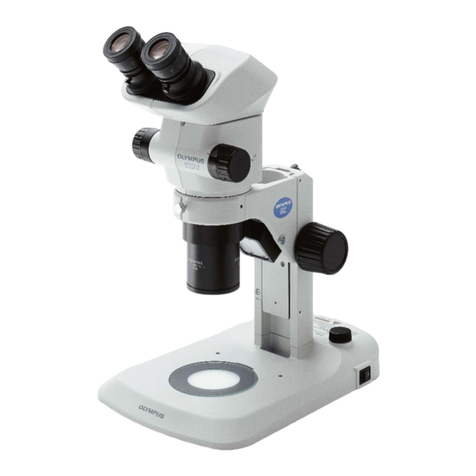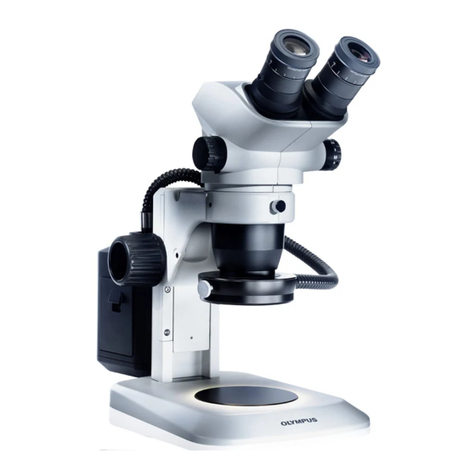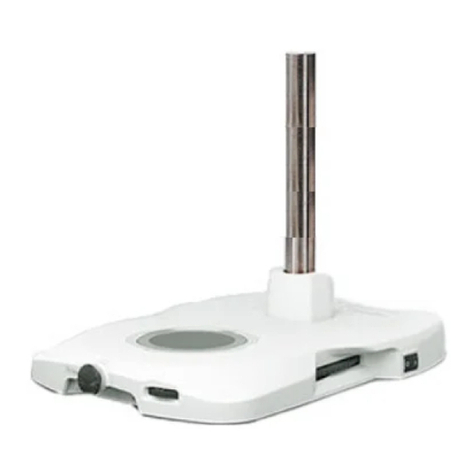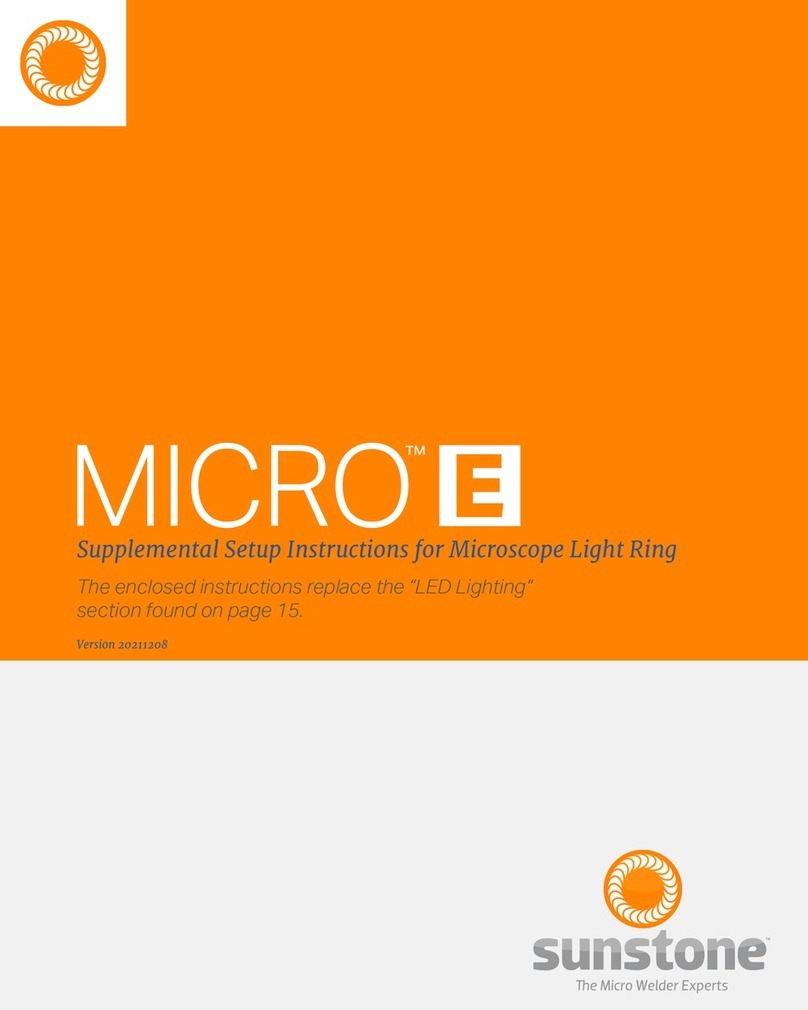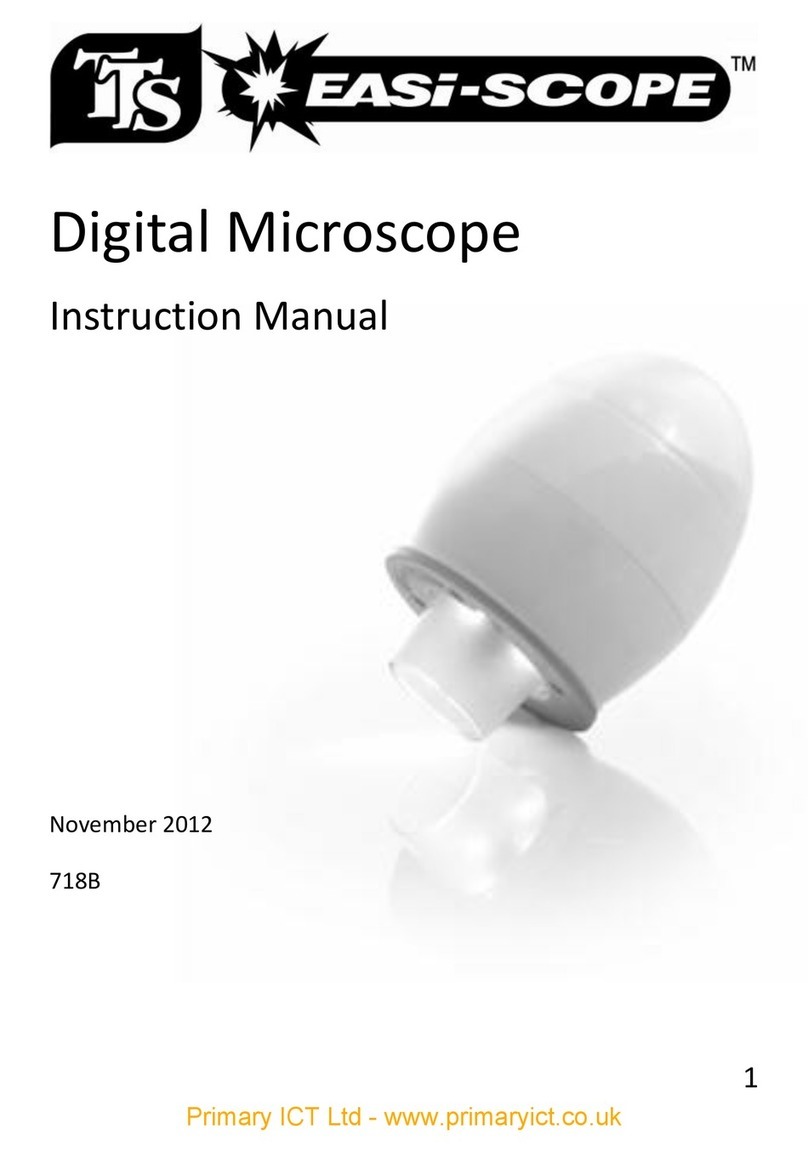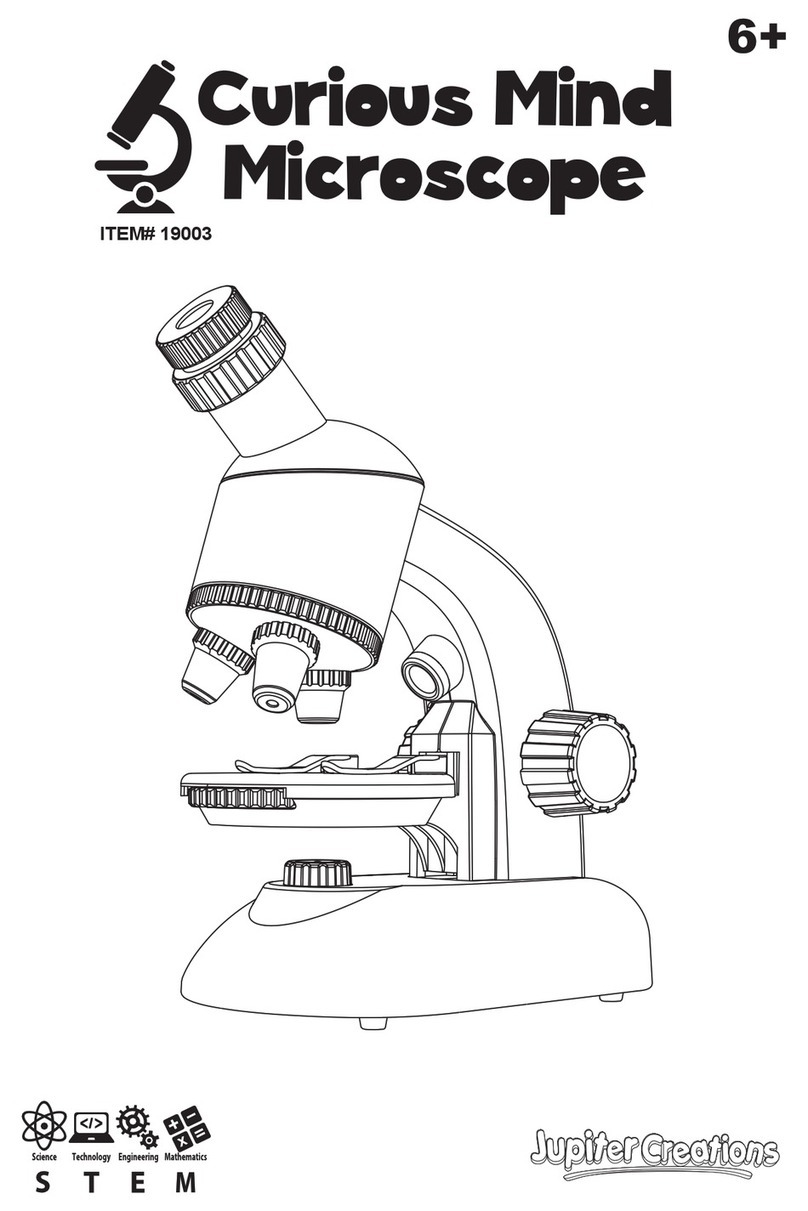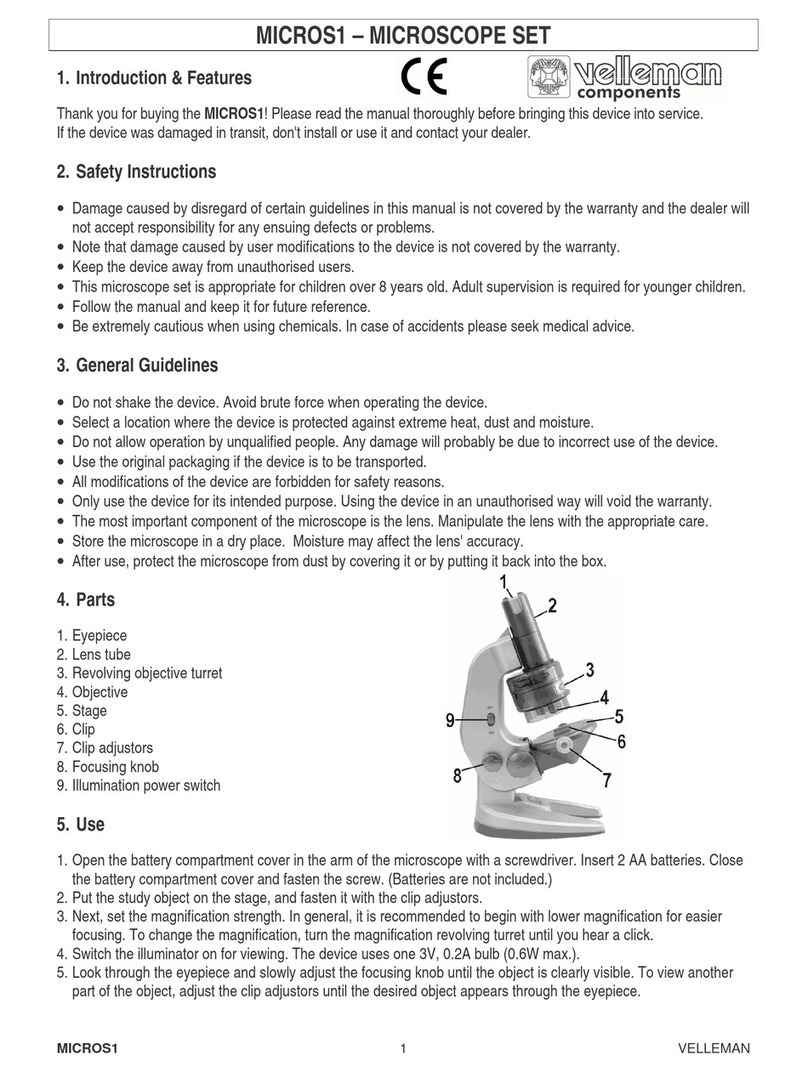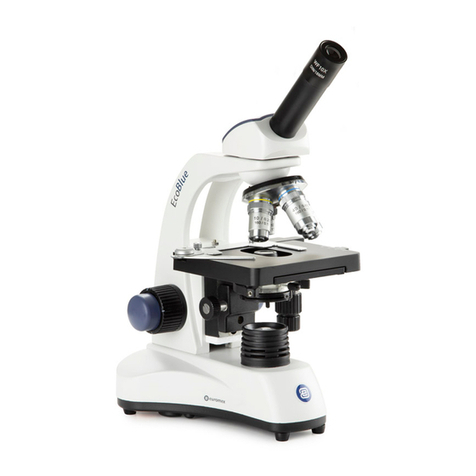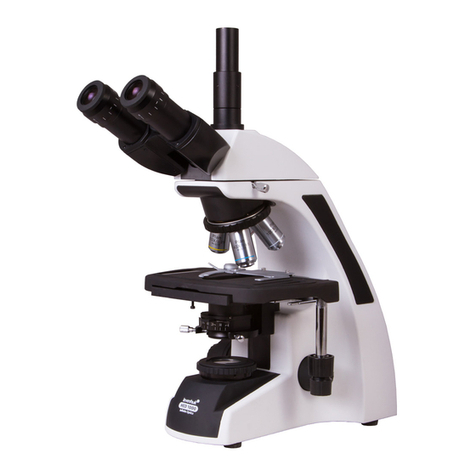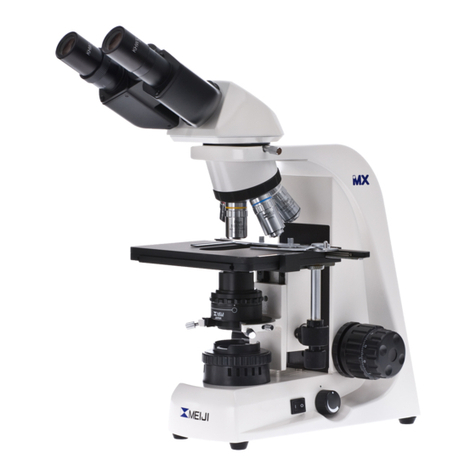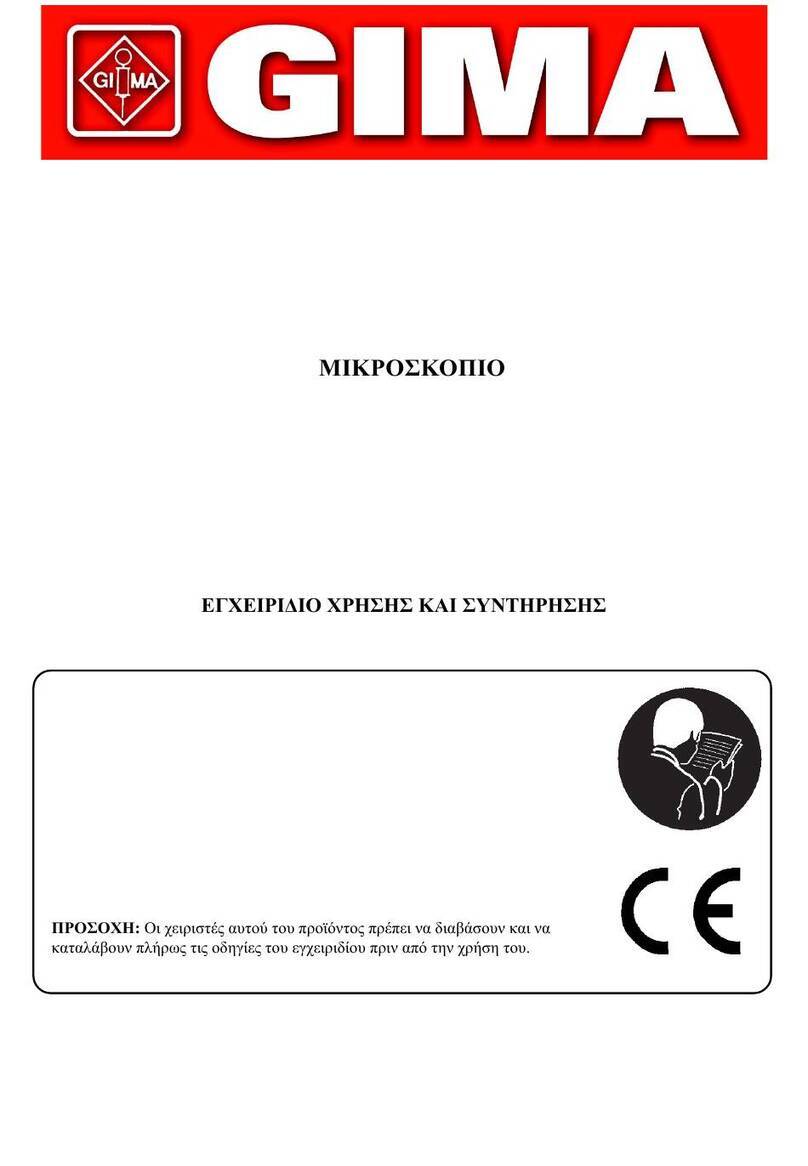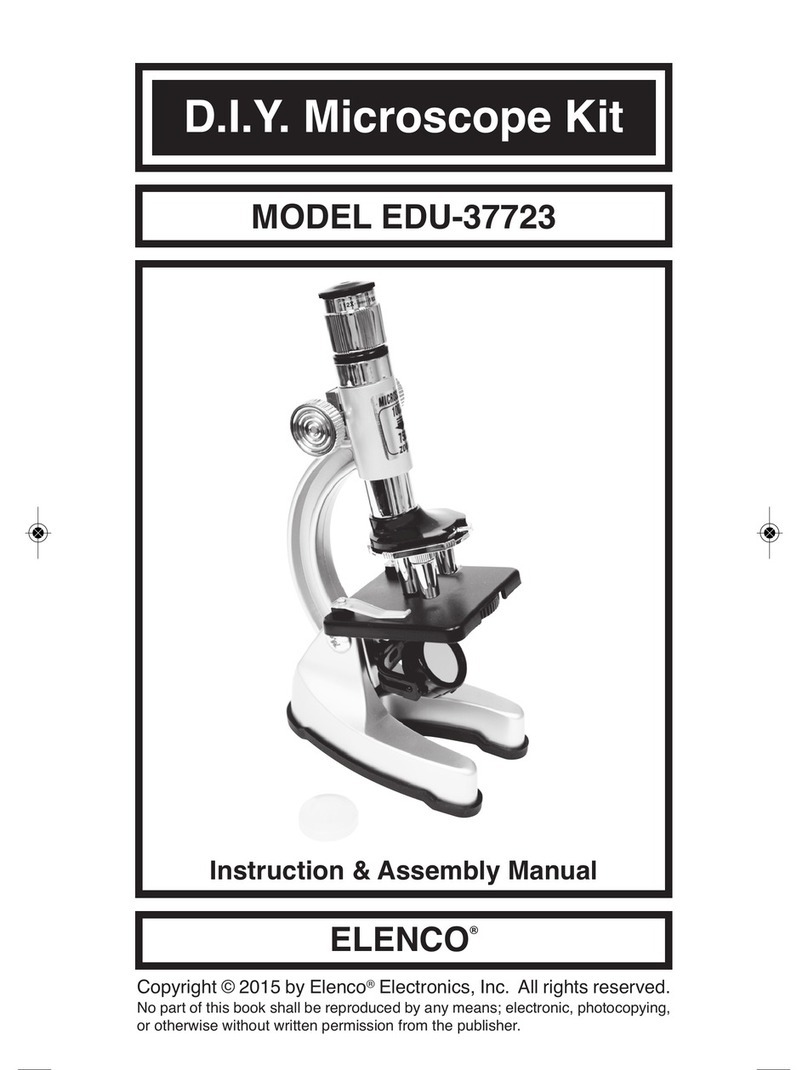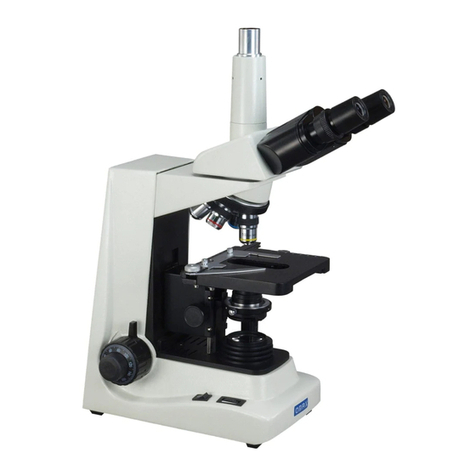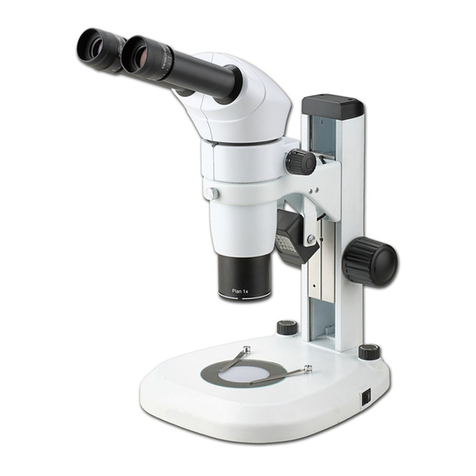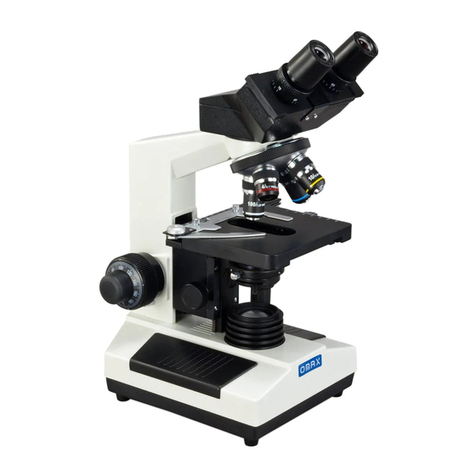Evident CX23 User manual

INSTRUCTIONS
This instruction manual is for the Olympus biological microscope.
To ensure the safety, obtain optimum performance and to familiarize yourself fully with the use
of this microscope, we recommend that you study this manual thoroughly before operating
this microscope, and always keep this manual at hand when operating this product.
Retain this instruction manual in an easily accessible place near the work desk for future
reference.
Biological Microscope
CX23
Optical Microscope and Accessory
With trinocular tube

In accordance with European Directive on Waste Electrical and Electronic Equipment, this
symbol indicates that the product must not be disposed of as unsorted municipal waste, but
should be collected separately.
Refer to your local Olympus distributor in EU for return and/or collection systems available in
your country.
NOTE: This product has been tested and found to comply with the limits for a Class A digital device,
pursuant to Part 15 of the FCC Rules. These limits are designed to provide reasonable protection
against harmful interference when the product is operated in a commercial environment. This product
generates, uses, and can radiate radio frequency energy and, if not installed and used in accordance
with the instruction manual, may cause harmful interference to radio communications.
Operation of this product in a residential area is likely to cause harmful interference in which case the
user will be required to correct the interference at his own expense.
FCC WARNING: Changes or modifications not expressly approved by the party responsible for compliance
could void the user’s authority to operate the product.
For Korea only
이 기기는 업무용 환경에서 사용할 목적으로 적합성평가를 받은 기기로서
가정용 환경에서 사용하는 경우 전파간섭의 우려가 있습니다.
FCC Supplier's Declaration of Conformity
Hereby declares that the product
Product name: Optical Microscope
Model Number: CX23RTFS2, CX23LTFS2
Conforms to the following specifications:
FCC Part 15, Subpart B, Section 15.107 and Section 15.109
Supplementary Information:
This device complies with part 15 of the FCC Rules. Operation is subject
to the following two conditions: (1) This device may not cause harmful
interference, and (2) this device must accept any interference received,
including interference that may cause undesired operation.
Responsible Party Name: Olympus Scientific Solutions Americas Corp.
Address: 48 Woerd Ave Waltham, MA 02453, U.S.A.
Phone Number: 781-419-3900

Safety precautions.....................................................................................................................................1
1 Standard combination.........................................................................................................................5
2 Nomenclature of operating portions......................................................................................6
3 Outline of brightfield/darkfield observation methods .............................................7
4 Observation procedures....................................................................................................................9
1Turning ON the LED illumination......................................................................................................................................9
2Selection between the eyepiece light path and the camera light path .....................................9
3Placing the specimen slide...............................................................................................................................................10
4Selecting the objective..........................................................................................................................................................12
5Focusing on the specimen................................................................................................................................................12
6Adjusting the interpupillary distance........................................................................................................................13
7Adjusting the diopter...............................................................................................................................................................14
8Adjusting the condenser position .............................................................................................................................15
9Adjusting the aperture diaphragm (AS) ................................................................................................................15
10 Adjusting the field diaphragm (FS).............................................................................................................................16
11 Attaching the darkfield ring slit (for darkfield observation only).......................................................18
12 Observation.....................................................................................................................................................................................19
13 Acquiring the image with the camera.....................................................................................................................19
14 Using the 100X oil immersion objective................................................................................................................20
Contents

5 Glossary of optical performance terminology .............................................................21
6 Troubleshooting......................................................................................................................................23
7 Specifications............................................................................................................................................25
8 List of optical performances........................................................................................................26
9 Assembly.......................................................................................................................................................27
9-1 Assembly diagram ........................................................................................................................................27
9-2 Assembly procedures................................................................................................................................28
1Removing the standard 10X eyepiece....................................................................................................................28
2Attaching the eyepiece micrometer..........................................................................................................................28
3Attaching the eyepieces (Standard 10X eyepieces or WHSZ15X-H)...........................................29
4Attaching the objective CXPL20X or CXPL100XO .......................................................................................29
5Attaching the filter of 45mm in diameter ..............................................................................................................29
6Attaching the auxiliary lens unit and field diaphragm unit....................................................................30
7Attaching the filter holderCH2-FH and darkfield ring slitCH2-DS ..................................................30
8Attaching the camera adapter U-TV1XC and the camera.....................................................................30
9Connecting the AC adapter and power cord...................................................................................................31
10 Attaching the allen wrench holder .............................................................................................................................32

1
CX23
If the product is used in a manner not specified by this manual, the safety of the user may be imperiled. In addition, the
product may also be damaged. Always use the product according to this instruction manual.
The following symbols are used in this instruction manual.
CAUTION : Indicates a potentially hazardous situation which, if not avoided, may result in
minor or moderate injury.
NOTE
: Indicates a potentially hazardous situation which, if not avoided, may result in
damage to the product or other property.
TIP
: Indicates the useful knowledge or information for use.
CAUTION Prevention of infection
CAUTION - Installation of the product
Wear protective equipment such as gloves, etc.
When you observe the specimens which have potentiality of infection, wear protective equipment such as gloves, etc.
to prevent the specimens from touching your skin directly.
When you maintain the product which may have contacted the specimens which have potentiality of infection, wear
protective equipment such as gloves, etc., or clean the product before operation.
After observation, clean the portions where specimens contacted directly.
Remove the specimen when moving the product.
When moving this product, be sure to remove the specimen first, since it is in danger of dropping and spattering.
In case the specimen is damaged, promptly take the infection prevention measures.
When disposing of the product, follow the regulations and rules of your local government.
When disposing of the product which contacted the specimens which have potentiality of infection, follow the
regulations and rules of your local government.
Install the microscope on a sturdy, level table or bench.
For safety in particular, do not place a mat, etc. under the product.
Safety precautions

2
CAUTION - Electric safety
Always use the AC adapter and power cord provided by Olympus.
If the proper AC adapter and the power cord are not used, the electric safety and the EMC (Electro-Magnetic
Compatibility) performance of the product cannot be assured. If no power cord is provided, please select the proper
power cord by referring to the section “Proper selection of the power cord” at the end of this instruction manual.
Always connect the ground terminal.
Check that the ground terminal of the power cord and that of the power outlet are connected properly. If the product is
not grounded, our intended electric safety and EMC performance of the product cannot be assured.
Do not use this product near the sources of strong electromagnetic radiation.
Proper operation may be interfered. Be sure to evaluate the electromagnetic environment before operating the product.
Disconnect the power cord in case of emergency.
In case of emergency, disconnect the power cord from the power cord connector of the product or from the power
outlet.
Install the product at the location where you can reach the power cord connector or the power outlet with your hand to
disconnect the power cord immediately.
This product complies with the emission and immunity requirements described in IEC61326 series.
CAUTION - LED (light emitting diode)
Do not look directly at the light from LED for a long time.
If you feel that the light from LED is too bright during observation, adjust the light intensity using the brightness
adjustment knob and continue observation. The LED built in this product is basically eye-safe. However, do not look
directly at the light from LED for a long time while feeling too bright, since it may cause damage to your eyes.
CAUTION - Safety symbols
The following symbols are attached to the product.
Study the meaning of the symbols and always use the product in the safest possible manner.
Symbol Meaning
Indicates a non-specific general hazard. Follow the description given after this symbol
or in the instruction manual.
Indicates that the main switch is ON.
Indicates that the main switch is OFF.

3
CX23
1. Be careful not to apply the impact or let the dirt/dust attached to the
microscope when carrying it.
2. Do not use the product in areas where it may be subjected to
direct sunlight, high temperature and/or humidity, dust or vibrations.
(For conditions of operating environments, see “7 Specifications” on
page 25.)
3. When installing the microscope, assure sufficient space around the
microscope.
4. When carrying this microscope, disconnect the AC adapter from the
microscope, and store the AC adapter and the power cord in the
microscope frame. Then, hold both sides of the arm as shown in the
lower left picture, and carry it carefully. It is easy to hold the arm by
putting the balls of fingers to the finger contact part a. (For procedures
to store the AC adapter and the power cord, see “Storing the AC adapter
and power cord” on page 31.)
·Do not hold the stage bor the tube c, since they may
be damaged. When carrying the microscope, be sure
to remove the specimen, filter, auxiliary lens and field
diaphragm unit in advance, since they are in a risk of
falling.
·Do not carry the microscope keeping the AC adapter
connected to the microscope. The AC adapter or the
microscope may be damaged by hitting the output
connector of the AC adapter.
·When carrying the microscope, be careful not to touch the
objective.
NOTE
Handling precautions
·This product is a precision instrument. Handle it with care
and avoid subjecting it to a sudden or severe impact.
·Never disassemble any part of the product. Otherwise,
failure could be caused.
·The objectives are screwed in tightly to prevent them from
being loosened during transportation. When removing the
objective, rotate it in the arrow direction as shown in the
picture on the left, using the slip prevention rubber sheet,
etc.
·Be sure to use the specified objectives (objectives
provided with the microscope frame and CX-Plan series).
If incorrect objectives are combined, the performance
cannot be delivered.
·The tube of this microscope is removable, but do not attach
the tube of other microscopes.
NOTE
b
c
a

4
1. Do not leave stains or fingerprints on the lenses and filters. If they get dirty, blow away dust with a commercially
available blower and gently wipe the lens or filter with a piece of cleaning paper (or clean gauze). Only when cleaning
fingerprints and oil stains, slightly moisten a piece of cleaning paper with commercially available absolute alcohol
and wipe them off with it.
Since the absolute alcohol is highly flammable, it must be handled carefully. Be sure to keep it away
from open flames or potential sources of electrical sparks. For example, the electrical equipment that
is switched ON and OFF may cause the ignition of a fire. Also, always use absolute alcohol only in a
well-ventilated room.
2. Wipe the portions other than the lens with a dry soft cloth. If the dirt cannot be removed by dry-wiping, moisten a soft
cloth with diluted neutral detergent and wipe the dirty surface with it.
Do not use organic solvents because they may deteriorate the coated surface or plastic parts.
3. After using this product, store it in a dry place or cover it with a dust cover. If you need the dedicated dust over (made
by Olympus), contact Olympus.
Do not use a highly sealable cover, such as a plastic bag, etc. as a dust cover. The humidity in the
microscope may increase to damage the product.
CAUTION
NOTE
NOTE
4. When cleaning the condenser, move the lever ato the left end
completely and use the condenser height adjustment knob bto
lower the condenser and remove it (see the picture on the left). Then,
clean the top lens portion thoroughly. When attaching the condenser,
engage the condenser with the attaching guide of the microscope
frame, and then push up the condenser until it stops.
Be careful not to attach the condenser to the other microscope
frame by mistake. If the condenser is combined to the incorrect
microscope frame, the performance will be deteriorated.
If the field diaphragm unit and the auxiliary lens unit are attached,
remove the field diaphragm unit and the auxiliary lens unit first
and then, remove the condenser.
5. When disposing of this product, be sure to follow the regulations and
rules of your local government. Contact Olympus for any questions.
NOTE
TIP
Maintenance and storage
Intended use
This product has been designed to be used to observe magnified images of specimens in various routine work and
research applications.
This includes the observation of living cells or of specimen taken from tissues to gain physiological or morphological
information at hospitals or laboratories. Typical field of applications are genetics, human blood and tissue examination,
neurology, pharmacology and cellular biology.
Do not use this instrument for any purpose other than its intended use.
This product complies with the requirements of directive 98/79/EC concerning in vitro
diagnostic medical devices. CE marking means the conformity to the directive.
This product is applied with the requirements of EMC standard IEC/EN61326-2-6 and
IEC/EN61326-1 concerning electromagnetic compatibility.
This product complies with the emission and immunity requirements described in IEC61326
series. The electromagnetic environment should be evaluated prior to operation of this product.
a
b

5
CX23
Refer to the drawing below and make sure that all necessary components are included in the product you purchased.
Option units
Eyepieces
Revolving
nosepiece
Stage
Power cord
AC adapter
· Eyepiece (2 pieces)
WHSZ15X-H
· Filter holder
CH2-FH
· Darkfield ring slit
CH2-DS
· Camera adapter
U-TV1XC
· Camera
DP22 or DP27
· 20X Objective
100X oil immersion objective
· Eyepiece micrometer
(Ø24 mm, Thickness: 1.5 mm)
Objective
Microscope
frame
Tube
Auxiliary lens
unit
Condenser
Field diaphragm
unit
1
1Standard combination

6
Tube fixing knob
Y-axis knob
Revolving nosepiece
X-axis knob
Main switch
: Power is ON.
: Power is OFF.
Fine focusing knob
Coarse focusing knob
Pre-focusing knob
Tension adjustment ring
Field
diaphragm ring
Specimen holder
Brightness
adjustment knob
(Diameter: 45mm)
Diopter
adjustment rings
Binocular portion
Condenser height
adjustment knob
Auxiliary lens
centering knobs
Light path
selection knob
Main switch
Tension adjustment ring
Condenser height
adjustment knob
Filter
Field
diaphragm ring
Filter holder
Specimen slide
Cover glass
Slide glass
Specimen
Specimen
Object for observation
Specimen slide
The specimen slide is the object where the specimen
is placed on the slide glass and the cover glass is
placed over it.
Aperture
diaphragm lever
Auxiliary lens
centering knobs
Coarse focusing knob
Coarse focusing knob
Fine focusing knob
Fine focusing knob
X-axis knob
Brightness
adjustment knob
2
2Nomenclature of operating portions
centering knobs
centering knobs

7
CX23
2 Brightness adjustment knob
1 Main switch 9
4 Specimen holder 10
5 X-axis/Y-axis knobs 10
3 Light path selection knob 9
7 Coarse/fine focusing knobs 12
2 Brightness adjustment knob 9
8 Binocular portion 13
6 Revolving nosepiece 12
7 Coarse/fine focusing knobs 12
b Aperture diaphragm lever 15
6 Revolving nosepiece 12
Observation
9 Diopter adjustment ring 14
2 Brightness adjustment knob 9
Place the specimen slide on the stage.
Engage the 10X objective in the light path.
Bring the specimen into focus and adjust the brightness.
Set the main switch to (ON) and adjust the brightness.
Raise the condenser to the upper limit position and adjust
the aperture diaphragm.
Adjust the brightness.
Select the light path. (Trinocular tube)
d Field diaphragm unit 16
(Operation portion) (Page)
Adjust the interpupillary
distance.
Adjust the diopter.
a Condenser height adjustment knob 15
e Auxiliary lens unit 16
Only for darkfield observation
Engage the objective you use in the light path and bring
the specimen into focus.
Place the darkfield
ring slit.
e Auxiliary lens unit 18
f Filter holder
30
Place the filter of 45mm
in diameter if necessary.
Adjust the field diaphragm.
c
Filter holder (window lens)
29
Place the filter of 32.5mm
in diameter if necessary.
e Auxiliary lens unit 18
f Filter holder
30
33Outline of brightfield/darkfield observation methods

8
d
f
e
b
f
f
b
d
4
6
8
a
7
7
7
Make a copy of this observation procedure guide and put it near the microscope to use for observation.
TIP
e
8
3
5
1
2
c
9

9
CX23
1Turning ON the LED illumination
Set the main switch ato (ON).
Rotating the brightness adjustment knob bin the arrow direction
increases the brightness and rotating it in the opposite direction
decreases the brightness. The values shown around the knob
represent the rough indication of brightness.
1
2
2Selection between the eyepiece light path and the camera light path
You can select the light path for observing the image with eyepieces or the
light path for observing the image on monitors, etc. via camera.
Rotate the light path selection knob aof the trinocular tube to select
the light path. (Light intensity ratio: 100:0)
: Eyepiece
: Camera
Be sure to rotate the light path selection knob completely
until it stops to acquire the proper observation image.
1
NOTE
a
a
b
4
4Observation procedures

10
Rotate the coarse focusing knob ain the arrow direction to fully
lower the stage.
Press the holding lever knob bbackward (arrow direction) to open
the specimen holding lever c, and place the specimen slide dby
sliding it on the stage from front toward back.
After placing the specimen slide, return the holding lever cgently.
Rotating the upper Y-axis knob emoves the specimen slide in the
Y-axis direction (front/back) and rotating lower X-axis knob fmoves
the specimen slide in the X-axis direction (right/left).
(Stage movable range: Depth(front/back) 30mm x Width (right/
left)76mm)
1
2
3
4
·Place the specimen slide carefully. If you return the holding
lever cwith excess force or release your hand from the
holding lever knob bin the middle, the lever may collide
with the specimen slide to damage it.
·Do not move the specimen slide by touching the specimen
holder gdirectly with hand, since it may damage the
rotary mechanism of X-axis/Y-axis knobs.
·The rotation torque of X-axis and Y-axis knobs becomes
heavier near the end of movable range of X-axis and Y-axis
knobs. In this case, stop rotating the knob.
NOTE
3Placing the specimen slide
Slide glass
It is recommended to use the slide glass awith a length of 76 mm, width
of 26 mm and thickness between 0.9 and 1.4 mm.
Use the cover glass bwith a thickness of 0.17mm to fully
deliver the performance of objective.
NOTE
b
a
g
e
f
cd
b
a

11
CX23
Stage operation in X/Y direction
Scale of specimen position
By reading and taking a note of X-axis and Y-axis scales (coordinates) of
the specimen observation position on the specimen slide, you can return
to the original observation position easily even if the specimen is moved.
The X-axis scale is read at the position on the specimen holder a.
The Y-axis scale is read at the position of index line b.
1
2
How to track the
image that moves
to the left (how to
move the image to the
right)?
Move the
specimen slide
to the front.
How to move
the image in the
lower area to the
upper area?
Move the
specimen slide
to the left.
Direction of moving the image
How to track an observation image
The up-down and left-right movements of the image
observed through eyepieces are opposite to the
movements of the specimen slide.
NOTE
b
a

12
5Focusing on the specimen
Rotate the coarse focusing knob ain clockwise direction (arrow
direction) facing the microscope from right side to move the objective
cto the specimen slide as close as possible.
While observing the specimen through the eyepieces, slowly rotate
the coarse focusing knob ain the direction opposite to the arrow
to lower the stage.
When the specimen comes into view, rotate the fine focusing knob
bto bring the specimen into focus precisely.
Working distance (WD)
The WD means the distance between the objective at the position where
the specimen is focused and the specimen slide.
Magnification
of objective 4X 10X 20X 40X 100X
W.D.
(mm) 27.8 8.0 2.5 0.6 0.13
1
2
3
The tension of the coarse focusing knob can be adjusted.
Insert a commercially-available flathead screwdriver into the groove dof
the tension adjustment ring. Rotating it clockwise (in the arrow direction)
increases the tension and counterclockwise decreases the tension of the
coarse focusing knob a.
If the stage descends by its own weight or the focus obtained
with the fine focusing knob bis lost soon, the tension is set
too loose. In this case, rotate the tension adjustment ring in the
arrow direction to increase the tension.
TIP
4Selecting the objective
Adjusting the tension of the coarse focusing knob
Hold the revolving nosepiece aand rotate it so that the intended
objective comes exactly above the specimen slide.
·Do not rotate the revolving nosepiece by holding the
objective.
·Be careful if you rotate the revolving nosepiece while
observing the edge of the specimen slide with the high
magnification objective (40X, etc.), the objective may
interfere with the specimen holder.
For attaching and removing the objectives, see page 29.
1
NOTE
TIP
W. D .
a
b
c
b
a
d
a

13
CX23
If the pre-focusing lever is not positioned appropriately,
the stage may not rise and the specimen may not be
focused. In this case, adjust the pre-focusing lever
position again.
It is recommended to use the pre-focusing lever, but if you don't
need it, place it at the upper limit position.
NOTE
TIP
6Adjusting the interpupillary distance
The interpupillary distance adjustment is to adjust the distance between
two eyepieces according to the distance between your eyes. This makes
it possible to observe a single image and to reduce eye strain during
observation.
Keep the right and left eyepieces horizontally. While looking through
the eyepieces, move the binocular portion either in aor bdirection
until the right and left fields of view coincide completely. The value
shown by the indicator (protrusion) con the left side eyepiece sleeve
represents your interpupillary distance.
·Note your interpupillary distance so that it can be easily
adjusted next time.
·You can adjust your interpupillary distance by moving the
binocular portion either to upper or lower side. Select the upper
side or the lower side according to your observation posture.
1
TIP
c
Using the pre-focusing lever
The pre-focusing lever prevents the specimen slide from being damaged
by collision between the specimen slide and objective.
After bringing the specimen into focus with the objective which has the
shortest WD, rotate the pre-focusing lever aclockwise until it stops.
To provide a certain margin for focusing range, rotate the pre-focusing
lever aby about half turn backward from the stopped position.
1
2
a
b
a

14
7Adjusting the diopter.
The diopter adjustment is to compensate for the difference in eyesights
of left and right eyes of the observer.
Rotate the diopter adjustment rings aof the right and left eyepieces
and move each scale “0” to each index b.
Engage the 10X objective in the light path and rotate the coarse/fine
focusing knobs to bring the specimen into focus.
Change to the 40X objective, and rotate the coarse/fine focusing knobs
to bring the specimen into focus.
Change to the 10X objective. While looking through the right eyepiece
with your right eye, rotate the diopter adjustment ring ato bring the
specimen into focus. In the same manner, while looking through the
left eyepiece with your left eye, rotate the diopter adjustment ring to
bring the specimen into focus.
Change to the 40X objective again, and rotate the coarse/fine focusing
knobs to bring the specimen into focus.
Change to the 10X objective. While looking through the right and left
eyepieces, confirm that the specimen is in focus
If the specimen is not in focus, repeat from 4to 6.
1
2
3
4
5
6
TIP
Eyepiece micrometer
For attaching the eyepiece micrometer, see page 28.
TIP
While looking through the eyepiece equipped with the eyepiece
micrometer, rotate the diopter adjustment ring ato adjust so that
the scales and lines of the eyepiece micrometer can be viewed clearly.
Engage the 10X objective in the light path. While looking through the
eyepiece equipped with the eyepiece micrometer, rotate the coarse/
fine focusing knobs to bring the specimen into focus.
While looking through the eyepiece which is not equipped with the
eyepiece micrometer, rotate the diopter adjustment ring ato bring
the specimen into focus.
1
2
3
When the eyepiece micrometer is attached to the eyepiece
0102030405060708090 100
a
a
b

15
CX23
a
Using the eye shades
When wearing eyeglasses
Use the eye shades in the normal, folded-down position.
When not wearing eyeglasses
Extend the folded eye shades in the arrow direction. Since the eye
shades prevent the unnecessary light from entering between eyepieces
and eyes, you can observe the specimen comfortably.
8Adjusting the condenser position
Raise the condenser height adjustment knob ato the upper limit
position.
1
The aperture diaphragm is a diaphragm to adjust the numerical aperture
of the condenser.
Adjusting the numerical aperture of the condenser appropriately
with respect to the numerical aperture of each objective allows
you to observe the specimen with the best contrast and resolution.
(For details, see page 22.)
The magnifications of objectives (4X, 10X, 40X, 100X) are displayed on
the front side of the condenser. Move the aperture diaphragm lever
ato the position of the magnification same as the objective in use.
For darkfield observation, open the aperture diaphragm.
1
NOTE
9Adjusting the aperture diaphragm (AS)
a

16
10 Adjusting the field diaphragm (FS)
Attach the auxiliary lens unit and field diaphragm unit.
If the filter holder is attached to the condenser, remove the filter
holder.
Auxiliary lens unit
Insert the auxiliary lens unit ato the lower area of the condenser
until the click sound is heard.
·Attach the centering knob bof the auxiliary lens
unit to match with the notch of the condenser (see
the picture below).
·When removing the auxiliary lens unit a, be sure
to hold it and push it down.
Do not press down the centering knob btoo
strongly to prevent the auxiliary lens from shifting
the position.
If the filter of 45mm in diameter needs to be attached, place it
on the filter holder (window lens) of the microscope frame prior
to attaching the field diaphragm unit.
Field diaphragm unit
Insert the field diaphragm unit cto the upper area of the window
lens of the microscope frame until the click sound is heard.
Attach the field diaphragm unit cso that the
protrusions dat the bottom come to the right and
left viewing from the front of the microscope in order
to match the tab (2 positions) with the tab holes of
the microscope frame.
d
Engage the 10X objective in the light path to bring the specimen
into focus.
1
TIP
NOTE
TIP
NOTE
2
The field diaphragm is a diaphragm to adjust the illumination area of the specimen.
By adjusting the illumination area slightly wider than the field of view depending on objectives to be used, the excess light
can be blocked to acquire the image with good contrast.
When carrying the microscope, remove the field diaphragm unit or the auxiliary lens unit in advance,
since they may be dropped.
NOTE
b
a
c
Table of contents
Other Evident Microscope manuals


